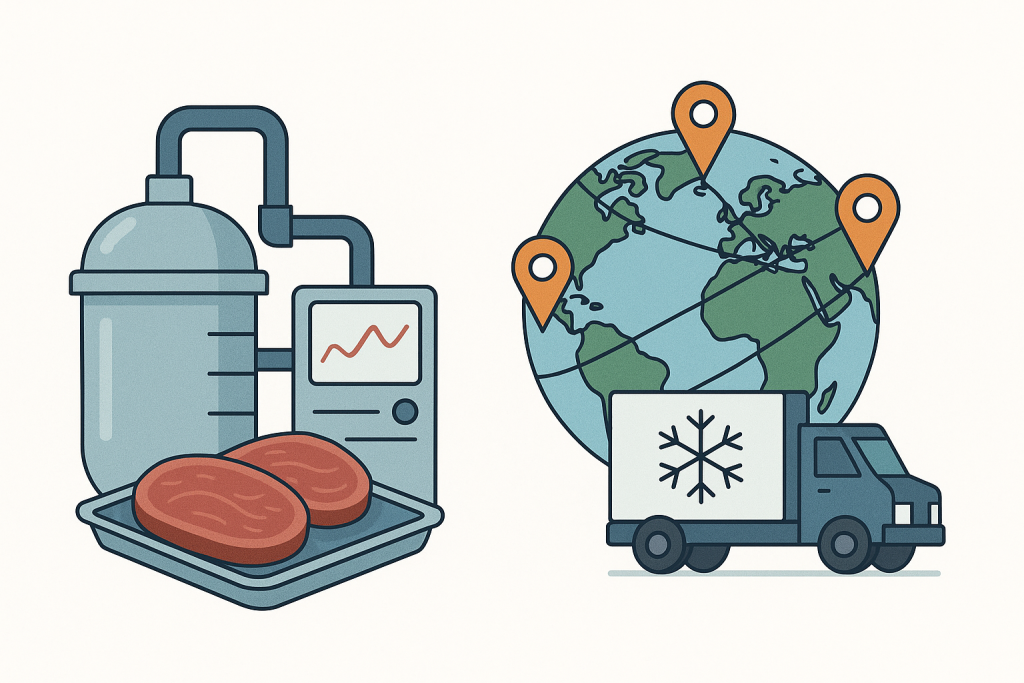When food production goes local, the global cold chain may start to melt away.
What Is the Cold Chain—and Why It Matters
The cold chain is the invisible infrastructure behind modern food systems: refrigerated trucks, warehouses, and shipping containers that keep meat, dairy, and produce from spoiling. It’s one of the largest energy consumers in the global economy, responsible for about 4% of total greenhouse gas emissions.
But the rise of cell-based meat—real animal protein grown from cells rather than livestock—could change how we think about food logistics entirely.
How Lab-Grown Meat Could Localize Food Production
Unlike traditional livestock systems, cultivated meat production isn’t bound by geography. It doesn’t require fertile land, vast water resources, or a temperate climate. Instead, it needs bioreactors, cell lines, and growth media—technologies that can operate in controlled environments almost anywhere on Earth.
This opens the door to localized protein production, where small regional or even urban facilities produce meat close to the point of consumption. No herds to transport. No carcasses to refrigerate. No global cold chain to maintain.
In theory, a school district in Kenya or a city in India could one day produce its own protein supply, tailored to local nutritional needs, without relying on imported frozen meat.
Reducing Refrigeration: The Hidden Climate Dividend
The cold chain’s energy footprint is immense. Every link—from storage warehouses to cargo ships—relies on refrigerants that often leak hydrofluorocarbons (HFCs), potent greenhouse gases thousands of times stronger than CO₂.
If cell-based meat facilities can produce protein on demand, the need for long-distance frozen transport could fall dramatically. This shift could:
- Cut emissions by reducing refrigeration reliance.
- Eliminate spoilage through just-in-time production.
- Lower food waste, which today accounts for nearly a third of all food produced globally.
Lab-grown meat could transform not only what we eat but how we distribute and preserve it.
The Technical Catch: Cultivated Meat Still Needs Cooling
Despite its efficiency, cell-based meat isn’t entirely cold-free. Cells must be grown in carefully controlled environments, typically between 36–38°C—close to body temperature. Once harvested, the meat still requires cooling during processing and storage to maintain food safety.
However, this refrigeration is localized and short-term, not dependent on transcontinental cold logistics. The difference is scale: a distributed network of micro cold systems instead of a single, energy-hungry global chain.
Implications for Developing Regions
For developing nations, localized cultivated meat could solve a long-standing challenge: how to deliver protein safely without expensive cold infrastructure.
Currently, billions of people live in regions where electricity is unreliable, making cold storage difficult. By decentralizing production, cell-based systems could bypass that barrier altogether. Portable bioreactors or modular “food hubs” could generate fresh protein directly within communities.
The potential benefits are profound:
- Improved food security through local control.
- Reduced import dependency on refrigerated goods.
- Economic empowerment via regional biotech hubs and workforce development.
This isn’t just an efficiency story—it’s an equity story.
The Economics of Distribution
Traditional meat supply chains rely on economies of scale, centralizing production in massive slaughterhouses and distributing globally. Cultivated meat reverses that logic. Its model is decentralized scalability—smaller, automated facilities that can replicate consistent quality anywhere.
Software and sensors, not geography, become the organizing logic of the food system. Over time, data-driven networks could replace logistics-driven ones, creating an “internet of protein”—distributed, traceable, and customizable.
Teaching the Next Generation of Food Thinkers
For educators and parents, the collapse of the cold chain offers a tangible way to discuss the intersection of climate, technology, and ethics. Students can explore:
- How global supply chains shape food access.
- The environmental trade-offs between refrigeration and biotechnology.
- What “local” really means in a digitally connected food economy.
These are not theoretical exercises—they’re the foundational questions of 21st-century food literacy.
The Bigger Picture
The move toward cell-based food systems won’t eliminate cold chains overnight. But as production localizes and logistics shrink, our reliance on energy-intensive refrigeration will inevitably fade.
The true promise of lab-grown meat isn’t just sustainability—it’s self-sufficiency. By decoupling food from distance, we begin to design a food system that is not only smarter, but fairer and more resilient.


